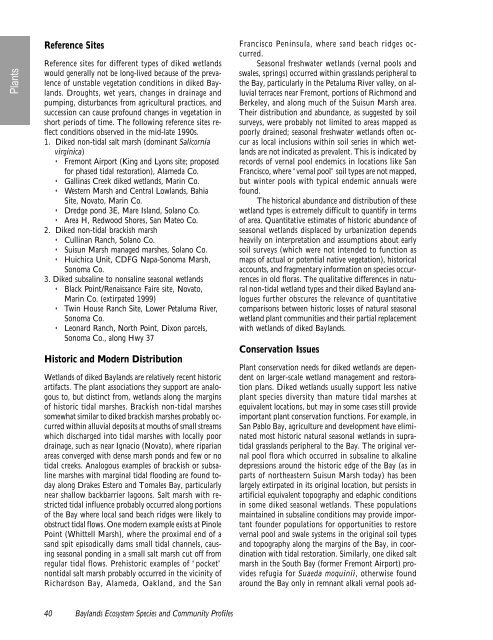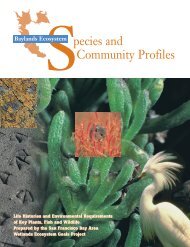Species and Community Profiles - San Francisco Estuary ...
Species and Community Profiles - San Francisco Estuary ...
Species and Community Profiles - San Francisco Estuary ...
Create successful ePaper yourself
Turn your PDF publications into a flip-book with our unique Google optimized e-Paper software.
Plants<br />
Reference Sites<br />
Reference sites for different types of diked wetl<strong>and</strong>s<br />
would generally not be long-lived because of the prevalence<br />
of unstable vegetation conditions in diked Bayl<strong>and</strong>s.<br />
Droughts, wet years, changes in drainage <strong>and</strong><br />
pumping, disturbances from agricultural practices, <strong>and</strong><br />
succession can cause profound changes in vegetation in<br />
short periods of time. The following reference sites reflect<br />
conditions observed in the mid-late 1990s.<br />
1. Diked non-tidal salt marsh (dominant Salicornia<br />
virginica)<br />
Fremont Airport (King <strong>and</strong> Lyons site; proposed<br />
for phased tidal restoration), Alameda Co.<br />
Gallinas Creek diked wetl<strong>and</strong>s, Marin Co.<br />
Western Marsh <strong>and</strong> Central Lowl<strong>and</strong>s, Bahia<br />
Site, Novato, Marin Co.<br />
Dredge pond 3E, Mare Isl<strong>and</strong>, Solano Co.<br />
Area H, Redwood Shores, <strong>San</strong> Mateo Co.<br />
2. Diked non-tidal brackish marsh<br />
Cullinan Ranch, Solano Co.<br />
Suisun Marsh managed marshes, Solano Co.<br />
Huichica Unit, CDFG Napa-Sonoma Marsh,<br />
Sonoma Co.<br />
3. Diked subsaline to nonsaline seasonal wetl<strong>and</strong>s<br />
Black Point/Renaissance Faire site, Novato,<br />
Marin Co. (extirpated 1999)<br />
Twin House Ranch Site, Lower Petaluma River,<br />
Sonoma Co.<br />
Leonard Ranch, North Point, Dixon parcels,<br />
Sonoma Co., along Hwy 37<br />
Historic <strong>and</strong> Modern Distribution<br />
Wetl<strong>and</strong>s of diked Bayl<strong>and</strong>s are relatively recent historic<br />
artifacts. The plant associations they support are analogous<br />
to, but distinct from, wetl<strong>and</strong>s along the margins<br />
of historic tidal marshes. Brackish non-tidal marshes<br />
somewhat similar to diked brackish marshes probably occurred<br />
within alluvial deposits at mouths of small streams<br />
which discharged into tidal marshes with locally poor<br />
drainage, such as near Ignacio (Novato), where riparian<br />
areas converged with dense marsh ponds <strong>and</strong> few or no<br />
tidal creeks. Analogous examples of brackish or subsaline<br />
marshes with marginal tidal flooding are found today<br />
along Drakes Estero <strong>and</strong> Tomales Bay, particularly<br />
near shallow backbarrier lagoons. Salt marsh with restricted<br />
tidal influence probably occurred along portions<br />
of the Bay where local s<strong>and</strong> beach ridges were likely to<br />
obstruct tidal flows. One modern example exists at Pinole<br />
Point (Whittell Marsh), where the proximal end of a<br />
s<strong>and</strong> spit episodically dams small tidal channels, causing<br />
seasonal ponding in a small salt marsh cut off from<br />
regular tidal flows. Prehistoric examples of “ pocket”<br />
nontidal salt marsh probably occurred in the vicinity of<br />
Richardson Bay, Alameda, Oakl<strong>and</strong>, <strong>and</strong> the <strong>San</strong><br />
40 Bayl<strong>and</strong>s Ecosystem <strong>Species</strong> <strong>and</strong> <strong>Community</strong> <strong>Profiles</strong><br />
<strong>Francisco</strong> Peninsula, where s<strong>and</strong> beach ridges occurred.<br />
Seasonal freshwater wetl<strong>and</strong>s (vernal pools <strong>and</strong><br />
swales, springs) occurred within grassl<strong>and</strong>s peripheral to<br />
the Bay, particularly in the Petaluma River valley, on alluvial<br />
terraces near Fremont, portions of Richmond <strong>and</strong><br />
Berkeley, <strong>and</strong> along much of the Suisun Marsh area.<br />
Their distribution <strong>and</strong> abundance, as suggested by soil<br />
surveys, were probably not limited to areas mapped as<br />
poorly drained; seasonal freshwater wetl<strong>and</strong>s often occur<br />
as local inclusions within soil series in which wetl<strong>and</strong>s<br />
are not indicated as prevalent. This is indicated by<br />
records of vernal pool endemics in locations like <strong>San</strong><br />
<strong>Francisco</strong>, where “ vernal pool” soil types are not mapped,<br />
but winter pools with typical endemic annuals were<br />
found.<br />
The historical abundance <strong>and</strong> distribution of these<br />
wetl<strong>and</strong> types is extremely difficult to quantify in terms<br />
of area. Quantitative estimates of historic abundance of<br />
seasonal wetl<strong>and</strong>s displaced by urbanization depends<br />
heavily on interpretation <strong>and</strong> assumptions about early<br />
soil surveys (which were not intended to function as<br />
maps of actual or potential native vegetation), historical<br />
accounts, <strong>and</strong> fragmentary information on species occurrences<br />
in old floras. The qualitative differences in natural<br />
non-tidal wetl<strong>and</strong> types <strong>and</strong> their diked Bayl<strong>and</strong> analogues<br />
further obscures the relevance of quantitative<br />
comparisons between historic losses of natural seasonal<br />
wetl<strong>and</strong> plant communities <strong>and</strong> their partial replacement<br />
with wetl<strong>and</strong>s of diked Bayl<strong>and</strong>s.<br />
Conservation Issues<br />
Plant conservation needs for diked wetl<strong>and</strong>s are dependent<br />
on larger-scale wetl<strong>and</strong> management <strong>and</strong> restoration<br />
plans. Diked wetl<strong>and</strong>s usually support less native<br />
plant species diversity than mature tidal marshes at<br />
equivalent locations, but may in some cases still provide<br />
important plant conservation functions. For example, in<br />
<strong>San</strong> Pablo Bay, agriculture <strong>and</strong> development have eliminated<br />
most historic natural seasonal wetl<strong>and</strong>s in supratidal<br />
grassl<strong>and</strong>s peripheral to the Bay. The original vernal<br />
pool flora which occurred in subsaline to alkaline<br />
depressions around the historic edge of the Bay (as in<br />
parts of northeastern Suisun Marsh today) has been<br />
largely extirpated in its original location, but persists in<br />
artificial equivalent topography <strong>and</strong> edaphic conditions<br />
in some diked seasonal wetl<strong>and</strong>s. These populations<br />
maintained in subsaline conditions may provide important<br />
founder populations for opportunities to restore<br />
vernal pool <strong>and</strong> swale systems in the original soil types<br />
<strong>and</strong> topography along the margins of the Bay, in coordination<br />
with tidal restoration. Similarly, one diked salt<br />
marsh in the South Bay (former Fremont Airport) provides<br />
refugia for Suaeda moquinii, otherwise found<br />
around the Bay only in remnant alkali vernal pools ad-



